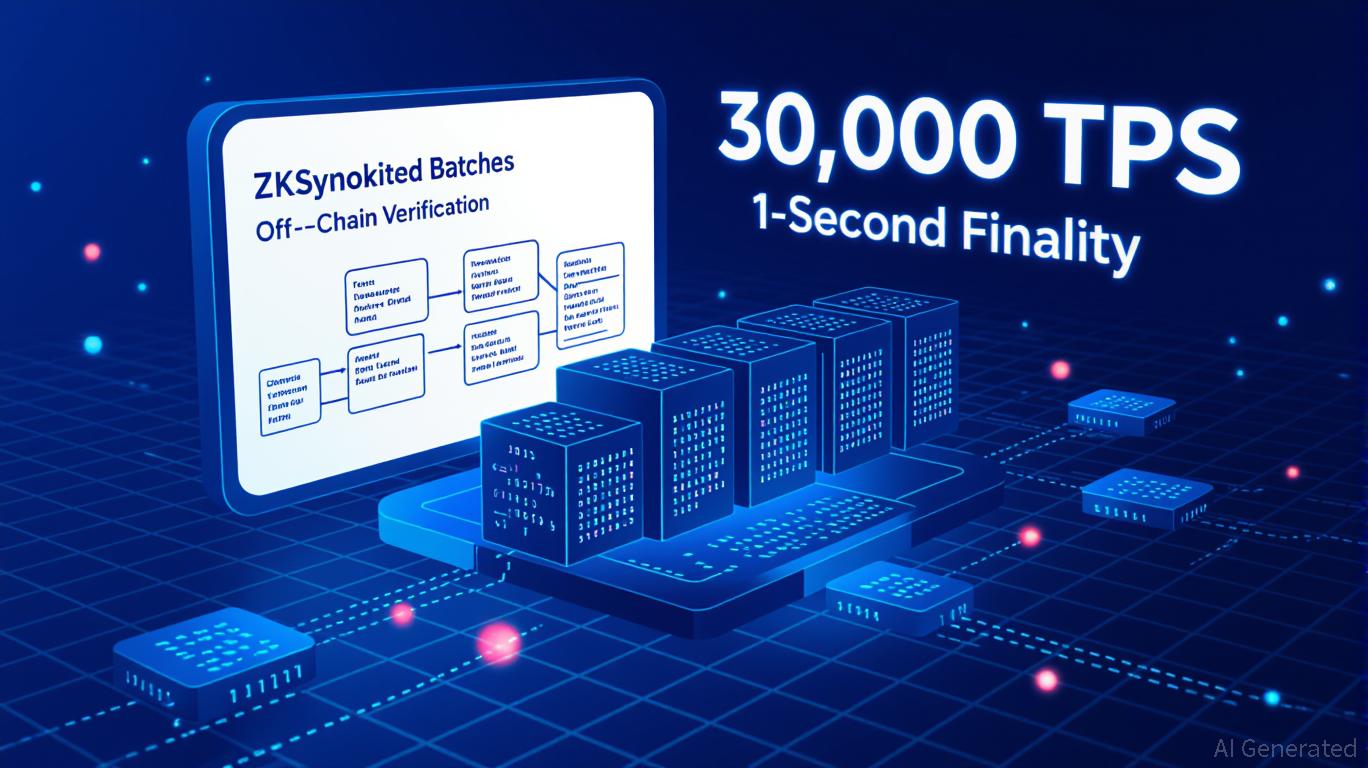Vitalik Buterin Supports ZKsync: What This Means for Layer 2 Scaling
- Vitalik Buterin endorses ZKsync, highlighting its ZK-rollup tech as critical for Ethereum's scalability and decentralization goals. - ZKsync's Atlas upgrade achieves 30,000 TPS with 1-second finality, enhancing programmability while maintaining on-chain security. - The project faces competition from Arbitrum and Optimism but differentiates through privacy, low fees, and Ethereum compatibility. - Rigorous audits and emergency response protocols strengthen ZKsync's security, though real-world performance r
Vitalik Buterin’s Support: Strategic Importance
Vitalik Buterin has repeatedly highlighted incorruptibility as Ethereum’s core attribute, guaranteeing data security and trust without relying on central authorities, as noted in a
ZKsync utilizes zero-knowledge (ZK) rollups to process transactions off-chain while preserving the security of the main chain. The latest Atlas upgrade has increased its throughput to 30,000 transactions per second (TPS) with 1-second finality, marking a significant efficiency improvement, according to Coinotag. Buterin’s support also includes advocating for the removal of Ethereum’s modexp precompile, an outdated feature that can increase the computational cost of ZK proofs by as much as 50 times, as detailed in a

Technical Strengths and Market Differentiation
ZKsync’s development roadmap places it as a strong competitor in the L2 sector of Ethereum. The Atlas upgrade not only accelerates transaction processing but also improves programmability, allowing advanced smart contracts and dApps to function with minimal delay, as reported by Coinotag. By the fourth quarter of 2025, ZKsync had handled 1.2 billion transactions, reflecting its reliability and growing adoption, according to Coinotag.
Nevertheless, ZKsync contends with major rivals such as
Security and Governance: Building Trust
Security remains paramount for any blockchain initiative. In 2025, ZKsync underwent comprehensive audits, including assessments by Spearbit and OpenZeppelin, as referenced in ZKsync’s documentation. The ZKsync Security Council (ZKSC) has shown responsiveness, recovering from the April 2025 airdrop incident and executing emergency updates, as reported by the ZKsync Security Council. These actions, along with a revised funding structure that prioritizes swift interventions, highlight the project’s dedication to strong governance, as outlined in the ZKsync Security Council report.
However, investors should exercise caution. While ZKsync’s technical achievements are notable, its ability to maintain performance under real-world pressures—such as heavy transaction loads or malicious attacks—will ultimately determine its sustainability, according to Coinotag.
Investment Outlook: Weighing Progress and Uncertainty
ZKsync’s investment prospects are rooted in its alignment with Ethereum’s scaling objectives and its technological progress. With Buterin’s endorsement and the Atlas upgrade, ZKsync has emerged as a prominent contender in the L2 “arms race.” Nonetheless, its future depends on several key factors:
1. Adoption Levels: Broad uptake by developers and users is essential. The 1.2 billion transactions processed by ZKsync indicate momentum, but rivals are also innovating, as noted by Coinotag and TokenMetrics.
2. Regulatory Environment: As L2s manage increasing value, regulatory developments could shape their growth.
3. Ethereum Enhancements: Planned changes such as the removal of modexp and other EIPs will have a direct impact on ZKsync’s efficiency, as mentioned in the Coinotag article.
From a risk and reward standpoint, ZKsync presents significant potential if it can secure a leading role in Ethereum’s L2 space. However, its dependence on Ethereum’s development path and the unpredictable nature of crypto markets call for a cautious approach.
Conclusion: Will ZKsync Shape Ethereum’s Next Era?
Vitalik Buterin’s backing of ZKsync goes beyond simple approval—it signals a strategic belief in ZK-rollups as the future of Ethereum’s scalability. Thanks to its technical progress, strong security measures, and alignment with Ethereum’s vision, ZKsync is well-placed to gain substantial market share. Still, investors must consider its prospects in light of intense competition and shifting regulations. For those willing to embrace innovation-driven risk with a long-term perspective, ZKsync stands out as a noteworthy example of blockchain’s coming evolution.
Disclaimer: The content of this article solely reflects the author's opinion and does not represent the platform in any capacity. This article is not intended to serve as a reference for making investment decisions.
You may also like
Dash rises 0.91% in 24 hours as autonomous technology investment plans emerge
- DoorDash plans increased autonomous delivery tech investment, triggering a 17% stock drop after announcing $数百M+ 2026 spending on robots like Dot. - Lyft and Uber similarly prioritize self-driving infrastructure, with Waymo partnership and $10-15M Nashville depot plans highlighting industry-wide automation bets. - DASH shows mixed 1-year performance (+117.07%) vs 7-day decline (-21.05%), while historical data reveals +4.7% 30-day excess returns post-earnings but no statistical significance.
BCH Drops 0.26% as Short-Term Price Fluctuations Approach Six-Month Minimums
- Bitcoin Cash (BCH) fell 0.26% in 24 hours but gained 15.58% over one year, showing mixed short- and long-term performance. - Technical indicators suggest consolidation, with a 200-day moving average above price and RSI at neutral 54, signaling no major trend reversal. - Reduced volatility has challenged backtesting models, forcing analysts to recalibrate event thresholds due to lack of extreme price swings since 2022.
ALGO Climbs 1.57% as Recent Profits Counteract Overall Downtrend
- ALGO rose 1.57% in 24 hours and 11.69% in 7 days, but fell 46.01% over 12 months, reflecting short-term speculative inflows and seasonal trading. - Analysts describe the rally as a cyclical bounce within a long-term bear trend, with technical indicators showing mixed signals and limited institutional buying. - The token remains below key resistance levels, with RSI in neutral territory and MACD bearish, suggesting the recent gains may be short-lived without stronger demand.
XRP Targets $26.6 as Fibonacci 1.618 Points to New 2025 Highs
